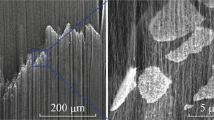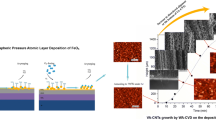Abstract
For the first time, the mechanism of growth of plate-like n-HA electrodeposited on superhydrophilic vertically aligned multi-walled carbon nanotubes (VACNT) is presented and a model for the specific growth preference is discussed. Results show that the carboxyl (carboxylic acid)/carboxylate functional groups directly attached on VACNT tips after oxygen plasma treatment were essential for the acceleration of the OH− formation and the deposition of plate-like HA crystals. FEG-SEM, EDX and XRD showed that a homogeneous highly crystalline HA film, stoichiometric and with preferential growth in the (002) plane direction, was formed.







Similar content being viewed by others
References
LeGeros RZ (2002) Properties of osteoconductive biomaterials: calcium phosphates. Clin Orthop Relat Res 395:81–98
Oyane A, Onuma K, Ito A, Kim HM, Kokubo T, Nakamura T (2003) Formation and growth of clusters in conventional and new kinds of simulated body fluids. J Biomed Mater Res A 64A:339–348
Vallet-Regi M, Gonzalez-Calbet JM (2004) Calcium phosphates as substitution of bone tissues. Prog Solid State Chem 32:1–31
Berman A, Ahn DJ, Lio A, Salmeron M, Reichert A, Charych D (1995) Total alignment of calcite at acidic polydiacetylene films: cooperativity at the organic-inorganic interface. Science 269:515–518
Balasundaram G, Webster TJ (2006) Nanotechnology and biomaterials for orthopedic medical applications. Nanomedicine 1:169–176
Correa-Duarte MA, Wagner N, Rojas-Chapana J, Morsczeck C, Thie M, Giersig M (2004) Fabrication and biocompatibility of carbon nanotube-based 3D networks as scaffolds for cell seeding and growth. Nanoletters 4:2233–2236
Lobo AO, Corat MAF, Antunes EF, Palma MBS, Pacheco-Soares C, Garcia EE, Corat EJ (2010) An evaluation of cell proliferation and adhesion on vertically-aligned multi-walled carbon nanotube films. Carbon 48:245–254
Nguyen-Vu TDB, Hua C, Cassell AM, Andrews RJ, Meyyappan M, Jun L (2007) Vertically aligned carbon nanofiber architecture as a multifunctional 3-D neural electrical interface. IEEE Trans Biomed Eng 54:1121–1128
Cai N, Wong CC, Gong YX, Tan SCW, Chan V, Liao K (2010) Modulating cell adhesion dynamics on carbon nanotube monolayer engineered with extracellular matrix proteins. ACS Appl Mater Interfaces 2:1038–1047
Namgung S, Kim T, Baik KY, Lee M, Nam JM, Hong S (2011) Fibronectin-carbon-nanotube hybrid nanostructures for controlled cell growth. Small 7:56–61
Salvetat JP, Bonard JM, Thomson NH, Kulik AJ, Forro L, Benoit W, Zuppiroli L (1999) Mechanical properties of carbon nanotubes. Appl Physa A-Mater 699:255–260
Endo M, Strano MS, Ajayan PM (2008) Potential applications of carbon nanotubes. Top Appl Phys 111:13–61
Bhattacharyya S, Guillott S, Dabboue H, Tranchant JF, Salvetat JP (2008) Carbon nanotubes as structural nanofibers for hyaluronic acid hydrogel scaffolds. Biomacromolecules 9:505–509
Cui D (2007) Advance and prospects of biomolecules functionalized carbon nanotubes. J Nanosci Nanotech 7:1298–1314
Ishizaki T, Saito N, Osamu Takai O (2010) Correlation of cell adhesive behaviors on superhydrophobic, superhydrophilic, and micropatterned superhydrophobic/superhydrophilic surfaces to their surface chemistry. Langmuir 26:8147–8154
Kim Y, Lee D, Oh Y, Choi J, Baik S (2006) The effects of acid treatment methods on the diameter dependent length separation of single walled carbon nanotubes. Synth Met 156:999–1003
Lakshminarayanan PV, Toghiani H Jr, Pittman CU (2004) Nitric acid oxidation of vapor grown carbon nanofibers. Carbon 42:2433–2442
Liu M, Yang Y, Zhu T, Liu Z (2005) Chemical modification of single-walled carbon nanotubes with peroxytrifluoroacetic acid. Carbon 43:1470–1478
Ramos SC, Vasconcelos G, Antunes EF, Lobo AO, Trava-Airoldi VJ, Corat EJ (2010) CO2 laser treatment for stabilization of the superhydrophobicity of carbon nanotube surfaces. J Vac Sci Technol B 28:1153–1158
Aryal S, Bahadur KCR, Dharmaraj N, Kim KW, Kim HY (2006) Synthesis and characterization of hydroxyapatite using carbon nanotubes as a nanomatrix. Scripta Mater 54:131–135
Boccaccinia AR, Choa J, Subhania T, Kayab C, Kayac F (2010) Electrophoretic deposition of carbon nanotube-ceramic nanocomposites. J Eur Ceram Soc 30:1115–1129
Hahna B-D, Lee J-M, Park D-S, Choi J–J, Ryua J, Yoon W-H, Lee B-K, Shin D-S, Kim H-E (2009) Mechanical and in vitro biological performances of hydroxyapatite–carbon nanotube composite coatings deposited on Ti by aerosol deposition. Acta Biomater 5:3205–3214
Najafi H, Nemati ZA, Sadeguian Z (2009) Inclusion of carbon nanotubes in a hydroxyapatite sol–gel matrix. Cer Inter 35:2987–2991
Manso M, Jiménez C, Morant C, Herrero P, Martínez-Duart JM (2000) Electrodeposition of hydroxyapatite coatings in basic conditions. Biomaterials 21:1755–1761
Eliaz N, Eliyahu M (2007) Electrochemical processes of nucleation and growth of hydroxyapatite on titanium supported by realtime electrochemical atomic force microscopy. J Biomed Mater Res A 80:621–634
Lobo AO, Corat MAF, Ramos SC, Matsushima JT, Granato AEC (2010) Fast preparation of hydroxyapatite/superhydrophilic vertically aligned multiwalled carbon nanotube composites for bioactive application. Langmuir 26(23):18308–18314
Antunes EF, Lobo AO, Corat EJ, Trava-Airoldi VJ, Martin AA, Veríssimo C (2006) Comparative study of first- and second-order Raman spectra of MWCNT at visible and infrared laser excitation. Carbon 44:2202–2221
Antunes EF, Lobo AO, Corat EJ, Trava-Airoldi VJ (2007) Influence of diameter in the Raman spectra of aligned multi-walled carbon nanotubes. Carbon 45:913–921
Lobo AO, Corat MAF, Antunes EF, Ramos SC, Pacheco-Soares C, Corat EJ (2010) Cytocompatibility studies of vertically-aligned multi-walled carbon nanotubes: raw material and functionalized by oxygen plasma. Mater Sci Eng C. doi:10.1016/j.msec.2010.08.010
Marciano FR, Marcuzzo JS, Bonetti LF, Corat EJ, Trava-Airoldi VJ (2009) Use of near atmospheric pressure and low pressure techniques to modification DLC film surface. Surf Coat Tech 204:64–68
Ramos SC, Vasconcelos G, Antunes EF, Lobo AO, Trava-Airoldi VJ, Corat EJ (2010) Wettability control on vertically-aligned multi-walled carbon nanotube surfaces with oxygen pulsed DC plasma and CO2 laser treatments. Diam Relat Mater 19:752–755
Hua R, Lin C, Shi H, Wanga H (2009) Electrochemical deposition mechanism of calcium phosphate coating in dilute Ca–P electrolyte system. Mater Chem Phys 115:718–723
Hueso JL, Espino JP, Caballero A, Cotrino J, Gonzalez-Elipe AR (2007) XPS investigation of the reaction of carbon with NO, O2, N2 and H2O plasmas. Carbon 45:89–96
Datsyuk V, Kalyv M, Papagelis K, Parthenios J, Tasis D, Siokou A, Kallitsis I, Galiotisa C (2008) Chemical oxidation of multiwalled carbon nanotubes. Carbon 46:833–840
Lu Y, Li W, Sun F, Zhao L, Xing L (2010) Highly hydroxylated carbon fibres as electrode materials of all-vanadium redox flow battery. Carbon 48:3079–3090
Estrade-Szwarckopf H (2004) XPS photoemission in carbonaceous materials: a ‘‘Defect’’ peak beside the graphitic asymmetric peak. Carbon 42:1713–1721
Okpalugo TIT, Papakonstantinou P, Murphy H, McLaughlin J, Brown NMD (2005) High resolution XPS characterization of chemical functionalized MWCNTs and SWCNTs. Carbon 43:153–161
Gerin PA, Dengis PB, Rouxhet PG (1995) Performance of XPS analysis of model biochemical compounds. J Chim Phy 92:1043–1065
Elzbieta P, Paul R (2003) Bulk and surface chemical functionalities of type III PAN-based carbon fibres. Carbon 41:1905–1915
Moulder JF, Stickle WF, Sobol PE, Bomben KD (1995) Handbook of X-ray photoelectron spectroscopy, perkin-elmer corporation. Eden Prairie, MN
Xu T, Yang J, Liu J, Fu Q (2007) Surface modification of multi-walled carbon nanotubes by O2 plasma. Appl Surf Sci 253:8945–8951
Chirila V, Marginean G, Brandl W (2005) Effect of the oxygen plasma treatment parameters on the carbon. Surf Coat Tech 200:548–551
Brandl W, Marginean G (2004) Functionalization of the carbon nanofibres by plasma treatment. Thin Solid Films 447:181–186
Kale S, Biermann S, Edwards C, Tarnowski C, Morris M, Long MW (2000) Three dimensional cellular development is essential for ex vivo formation of human bone. Nature Biotechnol 18:954–958
Elliot JC (1994) Structure and chemistry of the apatites and other calcium orthophosphates, chap 3. Elsevier, Amsterdam
Liu Y, Huang S, Dan X, Zhou K (2004) Growth of hydroxyapatite crystal in the presence of organic film. J Mater Sci Technol 20:223–226
Liao S, Xu G, Wang W, Watari F, Cui F, Ramakrishna S, Chan CK (2007) Self- assembly of nano-hydroxyapatite on multiwalled carbon nanotubes. Acta Biomater 3:669–675
Barrere F, Snel MME, Blitterswijka A, de Klaas G, Layrolle P (2004) Nanoscale study of the nucleation and growth of calcium phosphate coating on titanium implants. Biomaterials 25:2901–2910
Ban S, Maruno S (1993) Deposition of calcium phosphate on titanium by electrochemical process in simulated body fluid. Jpn J Appl Phys 32:L1577–L1580
Ban S, Hasegawa J (2002) Morphological regulation and crystal growth of hydrothermal electrochemically deposited apatite. Biomaterials 23:2965–2972
Lobo AO, Otubo J, Matsushima JT, Corat EJ (2011) Rapid obtaining of nano-hydroxyapatite bioactive films on NiTi shape memory alloy by electrodeposition process. J Mater Eng Perform 20:793–797
Patnaik P (2003) Handbook of inorganic chemicals. McGraw-Hill, NY, ISBN:0070494398
Pezzatini S, Solito R, Morbidelli L, Lamponi S, Boanini E, Bigi A, Ziche M (2006) The effect of hydroxyapatite nanocrystals on microvascular endothelial cell viability and functions. J Biomed Mater Res 76A:656–663
Damodaran R, Moudgil BM (1993) Electrophoretic deposition of calcium phosphates from non-aqueous media. Colloid Surf A Physicochem Eng Aspects 80:191–195
Redepenning J, Schlessinger T, Burnhum S, Lipiello L, Miyano J (1996) Characterization of electrolytically prepared brushite and hydroxyapatite coating on orthopaedic alloys. J Biomed Mater Res 30:287–294
Kikuchi M, Itoh S, Ichinose S, Shinomiya K, Tanaka J (2001) Self-organization mechanism in a bone-like hydroxyapatite/collagen nanocomposite synthesized in vitro and its biological reaction in vivo. Biomaterials 22:1705–1711
Aryal S, Bhattarai SR, Bahadur KCR, Khil MS, Lee D-R, Kim HY (2006) Carbon nanotubes assisted biomimetic synthesis of hydroxyapatite from simulated body fluid. Mater Sci Eng A 426:202–207
Kawashita M, Nakao M, Minoda M, Kim H, Beppu T, Miyamoto T et al (2003) Apatite forming ability of carboxyl group-containing polymer gels in a simulated body fluid. Biomaterials 24:2477–2484
Takeuchi A, Ohtsuki C, Miyazaki T, Tanaka H, Yamazaki M, Tanihara M (2003) Deposition of bone-like apatite on silk fiber in a solution that mimics extracellular fluid. J Biomed Mater Res 65:283–289
Toworfe G, Composto R, Shapiro I, Ducheyne P (2006) Nucleation and growth of calcium phosphate on amine-, carboxyl- and hydroxyl-silane self-assembled monolayers. Biomaterials 27:631–642
Mollazadeh S, Javadpour J, Khavandi A (2007) In situ synthesis and characterization of nano-size hydroxyapatite in poly(vinyl alcohol) matrix. Ceram Int 33:15791583
Saffar KP, Arshi AR, Jamilpour N, Najafi AR, Rouhi G, Sudak L (2010) A cross-linking model for estimating young′s modulus of artificial bone tissue grown on carbon nanotube scaffold. J Biomed Mater Res A 94:594–602
Cui W, Li X, Xie C, Zhuang H, Zhou S, Weng J (2010) Hydroxyapatite nucleation and growth mechanism on electrospun fibers functionalized with different chemical groups and their combinations. Biomaterials 31:4620–4629
Vijayaraghavan TV, Benesalem A (1994) Electrodeposition of apatite coating on pure titanium and titanium alloys. J Mater Sci Lett 13:1782–1785
Filgueiras MRT, Mkhonto D, de Leeuw NH (2006) Computer simulations of the adsorption of citric acid at previous termhydroxyapatitenext term surfaces. J Cryst Growth 294:60–68
Acknowledgments
This work was supported by FAPESP (07/00013-4, 06/03525-3). Special thanks to Maria Lucia Brison (LAS/INPE) for the SEM images, Diego Davi Coimbrão (UFSCar) for the high-resolution SEM and Marcelo E. H. Maia da Costa (PUC/Rio) for the XPS spectra. We would also like to thank the referees for the comments and recommendations on how to improve our work. We also very grateful for the special attention given by Professor Karl J. Jalkanen to improved the quality of this manuscript.
Author information
Authors and Affiliations
Corresponding author
Additional information
Dedicated to Professor Akira Imamura on the occasion of his 77th birthday and published as part of the Imamura Festschrift Issue.
An erratum to this article can be found at http://dx.doi.org/10.1007/s00214-011-1065-y
Rights and permissions
About this article
Cite this article
Lobo, A.O., Marciano, F.R., Regiani, I. et al. Proposed model for growth preference of plate-like nanohydroxyapatite crystals on superhydrophilic vertically aligned carbon nanotubes by electrodeposition. Theor Chem Acc 130, 1071–1082 (2011). https://doi.org/10.1007/s00214-011-0993-x
Received:
Accepted:
Published:
Issue Date:
DOI: https://doi.org/10.1007/s00214-011-0993-x




